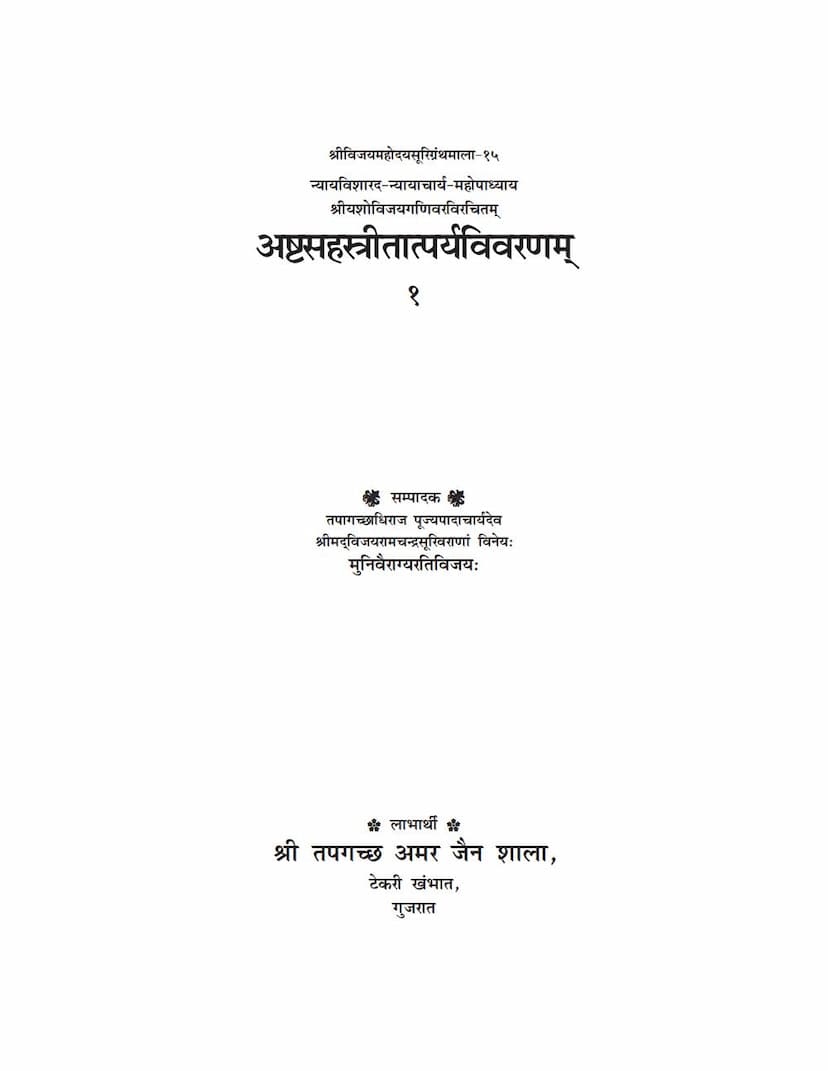Ashtasahastritatparya Vivaranam Part 1
Added to library: September 1, 2025

Summary
The provided text is the first part of "Ashtasahastritatparya Vivaranam," authored by Muni Shree Vairagyaratnivijayji, published by Pravachan Prakashan, Pune. This work is a commentary on the "Ashtasahastri," which itself is a commentary on the "Bhashya" of Bhattakalankadeva on the "Aptamimamsa" of Acharya Samantabhadra. The text delves into complex Jain philosophical and logical arguments, primarily engaging with the arguments presented in the "Aptamimamsa" and its commentaries from both Jain and non-Jain philosophical schools.
Here's a breakdown of the key aspects and themes covered in the provided sections:
1. Introduction and Sponsorship (Pages 1-5):
- Title: Ashtasahastritatparya Vivaranam, Part 1.
- Author: Muni Shree Vairagyaratnivijayji, a disciple of Tapa Gachhadhipati Acharya Shree Vijayaramchandrasurishwarji.
- Publisher: Pravachan Prakashan, Pune.
- Sponsorship: The publication is made possible by Shri Tapagachha Amar Jain Shala, Tekri, Khambhat, Gujarat, and supported by Shri Shriphalnagar Jain Shvetambar Murti Pujak Derasar Upashray Trust, Walkeshwar, Mumbai.
- Praise for the Editor: The editor, Muni Shree Vairagyaratnivijayji, is commended for his meticulous work, referencing approximately one thousand Jain and non-Jain texts and enriching the work with eleven appendices.
- Inspiration: The publication is credited to the inspiration of Acharya Shree Vijayhemabhushansurishwarji Maharaj.
- Endorsements: Several Acharyas, including Vijayhemabhushansuri and Vijayramchandrasurishwarji Maharaj, provide blessings and good wishes, highlighting the importance of detachment through knowledge and the value of this commentary.
2. Content and Structure: The text is a detailed exposition of Jain philosophy, particularly focusing on epistemology (Pramana) and metaphysics (Dravyanuyoga), as presented in the tradition of Mahopadyaya Yashovijayji. The commentary engages with various philosophical schools (Darshanas) and their arguments, often refuting them from a Jain perspective.
Key Philosophical and Logical Concepts Discussed:
- Aptamimamsa and its Commentaries: The core text being commented upon is Acharya Samantabhadra's "Aptamimamsa," which examines the nature of an "Apta" (an enlightened being worthy of trust) and establishes the omniscience and perfection of the Jinas. The commentary discusses the commentaries of Bhattakalankadeva ("Ashtashati") and Vidyānanda ("Ashtasahastri").
- Epistemology (Pramana):
- Aptapariksha (Examination of the Trustworthy): The text begins by analyzing the concept of an "Apta" and refuting claims that such a being might be flawed or untrustworthy.
- Saptabhangi (Seven-fold Predication): This is a central doctrine of Jainism used to describe reality from multiple viewpoints. The text delves into the nuances of Saptabhangi, including its application to concepts like existence, non-existence, and ineffability. It debates how these predicates apply to reality from different standpoints (Naya).
- Naya (Standpoints): The text explores various Nayas, such as Sangraha, Vyavahara, and Riju-Sutra, and how they are used to understand reality and resolve apparent contradictions.
- Perception (Pratyaksha): There's a significant discussion on the nature of perception, whether it is direct or indirect, sensory or extra-sensory, and the role of intervening factors like sense organs and mental faculties. The debate between direct perception (pratyaksha) and inferential knowledge (anumana) is a recurring theme.
- Anumana (Inference): The text critically examines the process of inference, the conditions for a valid inference (like the "three-jeweled syllogism" – Hetu, Udaharana, Nigamana), and the validity of inferential knowledge.
- Hetvabhāsa (Fallacies of Inference): Various logical fallacies are discussed and refuted, particularly those employed by other schools to challenge Jain tenets.
- Metaphysics (Dravyanuyoga):
- Nature of Reality: The text grapples with fundamental questions about the nature of reality, whether it is ultimately one or many, permanent or impermanent, dependent or independent. The Jain doctrine of Anekanta (non-absolutism) is presented as the means to reconcile these seemingly contradictory aspects.
- The Soul (Jiva): The nature of the soul, its consciousness, and its relation to its states (like bondage and liberation) are discussed.
- Causality (Karya-Karana): The Jain understanding of causality, particularly in relation to Anekanta, is explored. The commentary analyzes the concepts of cause and effect, the possibility of causes without effects, and vice versa.
- Anekanta-Vada (Non-absolutism): This core Jain principle, which posits that reality is multifaceted and can be understood from multiple viewpoints, is implicitly and explicitly defended against monistic (advaita) and nihilistic (shunyavada) viewpoints.
- Debates with Other Schools: A significant portion of the text is dedicated to engaging with and refuting the philosophical positions of various Indian schools of thought, including:
- Buddhism: Particularly the concepts of emptiness (Shunyavada), momentariness (Kshana-vada), and the denial of an eternal self or soul (Nairatmya-vada).
- Mimamsa: Arguments concerning the authority of the Vedas, the nature of injunctions (Vidhi), and the concept of an eternal sound (Shabda-nityata).
- Samkhya: Refutations of the Purusha-Prakriti dualism and the nature of liberation as pure consciousness.
- Advaita Vedanta: The concept of an undifferentiated, singular reality (Brahma) is challenged by the Jain emphasis on manifoldness (Anekanta).
- Nyaya and Vaisheshika: Debates often revolve around the nature of causation, perception, and the existence of categories like substance, attribute, and action.
Overall Goal: The book aims to provide a comprehensive and scholarly commentary on the "Ashtasahastritatparya," elucidating complex philosophical concepts with rigorous logic and extensive references. It serves as a defense and propagation of Jain philosophy, particularly its epistemological and metaphysical doctrines, against competing views. The work showcases the profound intellectual heritage of Jainism, particularly in the field of logic and dialectics, as championed by figures like Mahopadyaya Yashovijayji.
The detailed table of contents (अनुक्रमः) at the end indicates the vast scope of topics covered, ranging from specific logical arguments about perception and inference to broader metaphysical debates about the nature of reality, causality, and the soul.